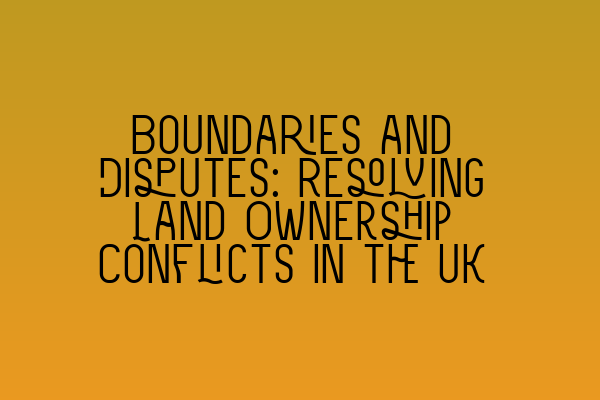Boundaries and Disputes: Resolving Land Ownership Conflicts in the UK
As a property owner or a prospective buyer in the UK, it’s crucial to have a clear understanding of land boundaries. The demarcation of property lines ensures the protection of your rights and prevents disputes over land ownership. Unfortunately, boundary disputes can arise due to various reasons, such as the misinterpretation of deeds, conflicting surveys, or disagreements between neighbors. In this article, we will explore the common causes of boundary disputes and provide guidance on how to resolve them effectively.
The Importance of Properly Defined Boundaries
Clearly defined boundaries are essential to protect your property rights and avoid legal conflicts. Boundaries determine the extent of your land ownership and dictate your rights of use, possession, and access. They play a crucial role in property transactions, as buyers need to be confident in the boundaries of the land they are purchasing.
It is vital to consult a seasoned property lawyer or solicitor to ensure that you have accurate information about your boundaries before making any property-related transactions. They can help you review title deeds, conduct surveys, and interpret any ambiguous information to establish a clear picture of your land’s boundaries.
Common Causes of Boundary Disputes
Boundary disputes can stem from a variety of factors, ranging from simple misunderstandings to complex legal issues. Here are a few common causes:
- Misinterpretation of Title Deeds: Title deeds, which outline property rights, can sometimes be vague or open to interpretation. Different interpretations of the language used in the documents can lead to disagreements regarding the exact location of boundaries.
- Inaccurate or Conflicting Surveys: Surveys can be prone to errors, leading to conflicting boundary lines. This situation commonly occurs when neighbors rely on separate surveys conducted at different times or by different surveyors.
- Encroachments: An encroachment occurs when a structure or object crosses the boundary line onto a neighboring property. For example, a fence, a tree, or a building that extends beyond the rightful owner’s land can lead to disputes.
- Adverse Possession: Adverse possession is a legal principle that allows an individual to claim ownership of another person’s land after using it continuously and openly for a specified period, typically 12 years. Disputes may arise when someone claims ownership of a portion of your land through adverse possession.
- Changes in Natural Land Features: Natural changes, such as erosion, landslides, or watercourse alterations, can alter the boundary lines over time. This can create confusion and disputes between neighboring landowners.
Resolving Boundary Disputes
When facing a boundary dispute, it is crucial to approach the situation calmly and seek effective resolution methods. Here are some steps you can take to resolve boundary disputes:
- Communication: Open communication with your neighbor is often the first step towards resolving boundary disputes. Share your concerns and try to find a mutually agreeable solution.
- Mediation: If direct communication fails, engaging in mediation can be beneficial. Mediation involves working with a neutral third party who helps facilitate discussions and guide both parties towards a resolution.
- Boundary Agreements: When both parties agree on the disputed boundary, a boundary agreement can be drawn up to legally document the new boundary line. This agreement should be signed and registered with the Land Registry to ensure its enforceability.
- Boundary Determination: In some cases, it may be necessary to seek a boundary determination from a court. This involves presenting evidence such as surveys, title deeds, or expert opinions to the court for a definitive ruling on the boundary dispute.
- Legal Action: As a last resort, legal action can be pursued. This may involve filing a claim in court to seek a judgment that clarifies the legal boundaries.
It is important to note that resolving boundary disputes can be a complex and time-consuming process. Seeking professional legal advice from a property lawyer or solicitor experienced in land disputes is highly recommended. They can guide you through the legal procedures, help gather evidence, and represent you in negotiations or court proceedings.
Conclusion
Boundary disputes can cause significant stress and affect the value and enjoyment of your property. Understanding the common causes and effective resolution methods is essential for protecting your property rights in the UK. Seeking guidance from a qualified property lawyer or solicitor can make a substantial difference in successfully resolving boundary disputes and ensuring a peaceful coexistence with your neighbors.
For more information on UK property laws, valuable updates, and essential guidelines, we recommend reading our related articles:
- Updates in UK Property Laws: Key Changes and Implications
- Legal challenges in property transactions: A comprehensive guide
- Navigating Lease Laws in the UK: Essential Guidelines for Tenants and Landlords
- Dominate Property Law Questions: Avoiding Common Pitfalls
- Land Law Revision Tips: Ace Your Exam Preparation
